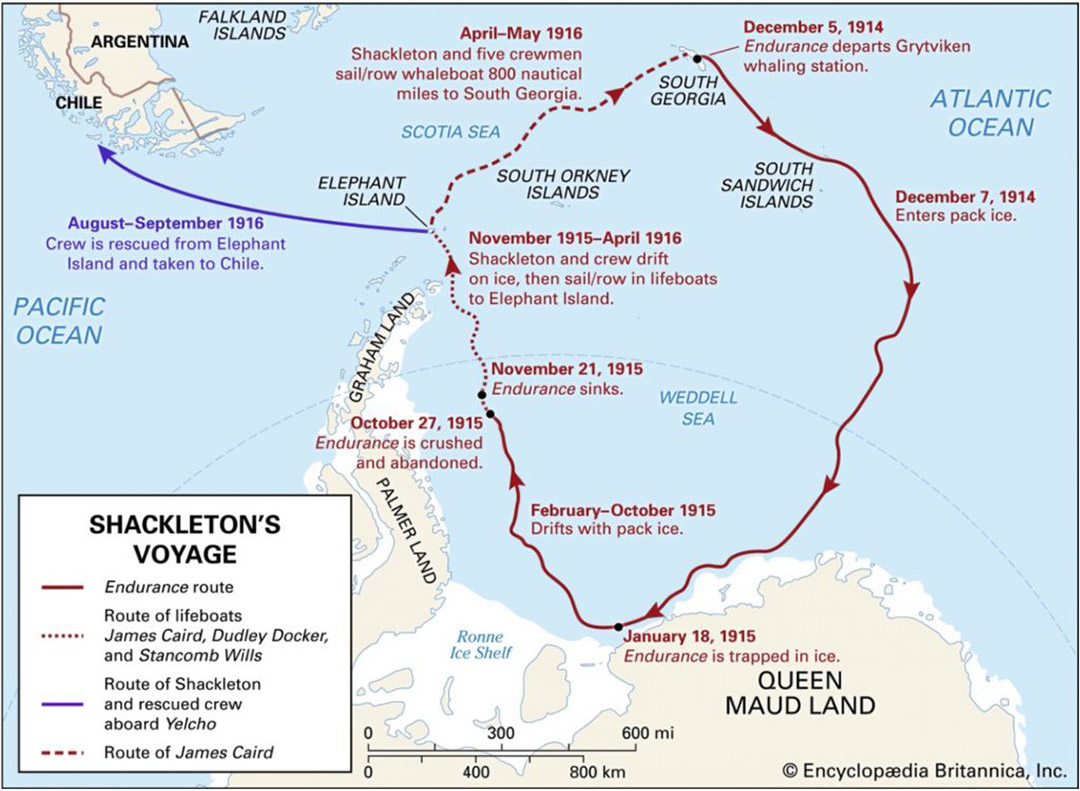
Endurance22 – the renewed search for the wreck of the Endurance, the ship of famous polar explorer Sir Ernest Shackleton lost in Antarctica, will start at the beginning of February. One hundred years after Shackleton’s death, the expedition, led by the Falklands Maritime Heritage Trust, will attempt to locate, survey and film the ship that had sunk in the Weddell Sea in November 1915.
Shackleton was already a respected, widely honored polar explorer when he set out in 1914 this time to cross Antarctica. In December, he and his crew set sail from South Georgia on the Endurance for Vahsel Bay in the Weddell Sea, from where the crossing of Antarctica was to begin. However, sea ice conditions made it impossible to reach the bay, forcing Shackleton to overwinter aboard. In October 1915, the crew had to abandon ship because the ice began to crush the ship. It sank on November 21, 1915. It was thanks to the experience, perseverance, and iron will of Shackleton and his 27 men that they survived their own rescue mission over the ensuing months and were finally all safe on August 30, 1916.
In 2019, more than one hundred years later, a first expedition in search of the Endurance was unsuccessful, and a new expedition is now to find and investigate the lost ship. Almost all preparations and test runs have been successfully completed, so that on February 5, the South African icebreaker Agulhas II will once again set off from Cape Town for the Weddell Sea.

“We are pleased to confirm that everything is on track for the expedition’s scheduled start from Cape Town on February 5. The entire team has been working tirelessly since July. The sea trials provided an excellent opportunity to thoroughly test the search technology and confirm its performance. In addition, the engineers and technicians had the opportunity to train under favorable conditions and gain valuable experience before testing their ability to launch through the ice. Although there is no guarantee of success, we are now well prepared and ready for this amazing exploration mission,” says polar explorer and expedition leader Dr John Shears.
The wreck is to be located by means of several hybrid underwater vehicles, which will also be used to investigate and film the Endurance. The SAAB Sabertooth combines the features of autonomous underwater vehicles (AUVs), which can follow a pre-programmed course, and remotely operated underwater vehicles (ROVs), which send digital signals to the surface in real time via a fiber-optic cable.

“It’s a unique privilege for the Trust to be able to put together the elements of this expedition. Shackleton faced the challenges of ice and war. Ice remains our biggest challenge, but Covid has been a threat throughout our planning and preparation. The captain, ice pilot and crew of the South African vessel Agulhas II are experienced and have proven in 2019 that they are capable of advancing to the wreck. “We are able to use the latest technology and we have an experienced team of marine archaeologists, scientists, engineers and technicians who can use their knowledge to locate and survey the wreck. Scientists will tell and explain more about the unique environment of the Weddell Sea. And our team of educators, filmmakers and program writers will tell stories of heroism, challenge and determination to a young, global audience that should inspire us all,” says Donald Lamont, the chairman of the Falklands Maritime Heritage Trust.
However, the team of the Endurance22 expedition, which consists of leading polar researchers, is not only focusing on the search for the wreck, but will also conduct a series of studies on the ice and climate change. Among other things, the measurement and recording of sea ice conditions will be used to develop a system that will, over time, provide continuous and automatic data on sea ice conditions in Antarctica, of which very little information is currently available.

In addition to research, the expedition team is particularly interested in bringing the story of Shackleton, his ship, and the members of his crew to a new and younger audience. To this end, the Falklands Maritime Heritage Trust is working with the media platform History Hit and the agency Little Dot Studios. A film crew will document from on board in real time and publish the footage on various digital channels and social media platforms.
Students are also to be addressed directly via the US-based education organization Reach the World. From the classroom, they should be able to interact with researchers. In addition, the Royal Geographical Society provides teaching and learning resources for use in the classroom, which students can use to explore changes in polar exploration and the various motivations for visiting Antarctica, as well as the unique frozen environment of this continent.
Hopes are up that the ice conditions will allow the expedition to reach the place where the Endurance sank according to the records of Captain Frank Worsley. Last but not least, questions like “What happened to the preserving jars and what was in them, and is the microscope still there?” or “What happened to Alexander Macklin’s diary?” want to be answered by exploration director Mensun Bound.
Julia Hager, PolarJournal
Link to the Endurance22 expedition: https://endurance22.org/
More on the subject:





